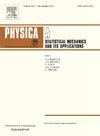Departure time choices and comparisons of household commuting based on the stochastic bottleneck model
IF 2.8
3区 物理与天体物理
Q2 PHYSICS, MULTIDISCIPLINARY
Physica A: Statistical Mechanics and its Applications
Pub Date : 2025-06-10
DOI:10.1016/j.physa.2025.130762
引用次数: 0
Abstract
This paper investigates the impact of the stochastic bottleneck capacity on morning household trips when the school is located near home. There is a bottleneck on the way from the school to the workplace. Each household first drops off their children at school and then goes to work every morning. Based on the Wardrop’s first principle, which minimizes the expected travel cost for each household, all possible equilibrium departure/arrival patterns are examined. The study analyzes how the total travel cost (TTC) and total queuing cost (TQC) vary with the school-work start time difference, with the degradation ratio of capacity and with the degradation probability. Additionally, we compare the results with the scenario where the school is near the workplace. Our findings show that the TTC is always larger when the school is near the workplace compared to when it is near home. However, the queuing cost comparison depends on the parameters. We further compare the results with those in the deterministic model. We find that the TTC in the stochastic model is always larger than that under the deterministic model, while it is not necessarily true for the TQC. We also analyze the Pareto frontiers of TTC and TQC with respect to the school-work start time difference. This study captures the significance of school location and traffic uncertainty in determining the effectiveness of traffic management policies for household trips.
基于随机瓶颈模型的家庭通勤出发时间选择与比较
本文研究了当学校离家庭较近时,随机瓶颈容量对家庭早晨出行的影响。从学校到工作场所的路上有一个瓶颈。每个家庭每天早上先把孩子送到学校,然后再去上班。基于Wardrop的第一原则,即最小化每个家庭的预期旅行成本,所有可能的均衡出发/到达模式都被检查。研究分析了总出行成本(TTC)和总排队成本(TQC)随课业开始时差、容量退化率和退化概率的变化规律。此外,我们将结果与学校靠近工作场所的情况进行了比较。我们的研究结果表明,当学校靠近工作场所时,TTC总是比学校离家近时更大。然而,排队成本的比较取决于参数。我们进一步将结果与确定性模型中的结果进行比较。我们发现随机模型下的TTC总是大于确定性模型下的TTC,而对于TQC则不一定如此。我们还分析了TTC和TQC的帕累托边界对学校作业开始时间差异的影响。本研究抓住学校位置和交通不确定性在决定家庭出行交通管理政策有效性中的重要性。
本文章由计算机程序翻译,如有差异,请以英文原文为准。
求助全文
约1分钟内获得全文
求助全文
来源期刊
CiteScore
7.20
自引率
9.10%
发文量
852
审稿时长
6.6 months
期刊介绍:
Physica A: Statistical Mechanics and its Applications
Recognized by the European Physical Society
Physica A publishes research in the field of statistical mechanics and its applications.
Statistical mechanics sets out to explain the behaviour of macroscopic systems by studying the statistical properties of their microscopic constituents.
Applications of the techniques of statistical mechanics are widespread, and include: applications to physical systems such as solids, liquids and gases; applications to chemical and biological systems (colloids, interfaces, complex fluids, polymers and biopolymers, cell physics); and other interdisciplinary applications to for instance biological, economical and sociological systems.

 求助内容:
求助内容: 应助结果提醒方式:
应助结果提醒方式:


